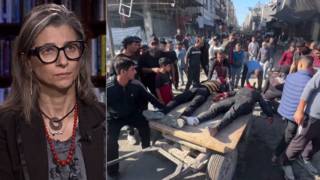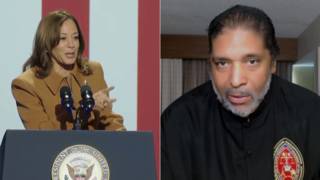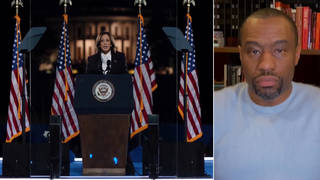
Related
Topics
Guests
- Scott Hortonhuman rights attorney and contributing editor at Harper’s Magazine. He is also a lecturer at Columbia Law School. His latest article for Harper’s is called “The Guantánamo 'Suicides' Revisited.”
In one of the great mysteries of the U.S. military prison at Guantánamo Bay, three prisoners, two from Saudi Arabia and one from Yemen, died the night of June 9, 2006. Authorities at Guantánamo said the three men — Yasser Talal al-Zahrani, Salah Ahmed al-Salami and Mani Shaman al-Utaybi — had killed themselves. The commander at Guantánamo, Rear Admiral Harry Harris, described their deaths as an “act of asymmetrical warfare waged against us.” But explosive new evidence shows there may have been a cover-up on how the men actually died. Recently discovered pages from the Naval Criminal Investigative Service suggest that the men died not from suicide, but torture. The new evidence includes an eyewitness account of al-Zahrani on the night of his death which indicates he may have died from torture and suffocation during questioning at a secret black site facility at Guantánamo known as Camp No, or Penny Lane. Harper’s Magazine contributing editor Scott Horton first raised questions about what happened on that night in a 2010 investigation that won a National Magazine Award for Reporting. He has just uncovered the new details on the deaths for a new article in Harper’s, “The Guantánamo 'Suicides' Revisited.” A human rights attorney and lecturer at Columbia Law School, Horton is author of the forthcoming book, “The Lords of Secrecy: The National Security Elite and America’s Stealth Foreign Policy.”
Transcript
NERMEEN SHAIKH: We turn now to one of the great mysteries of Guantánamo. On the night of June 9th, 2006, three prisoners—two from Saudi Arabia and one from Yemen—died at the prison. Authorities at Guantánamo said the three men—Yasser Talal al-Zahrani, Salah Ahmed al-Salami and Mani Shaman al-Utaybi—had killed themselves. The commander at Guantánamo, Rear Admiral Harry Harris, described their deaths as a, quote, “act of asymmetrical warfare waged against us.”
But explosive new evidence shows there may have been a cover-up on how the men actually died. Recently discovered pages from the Naval Criminal Investigative Service suggest that the men died not from suicide, but torture. The new evidence includes an eyewitness account of al-Zahrani on the night of his death which indicates he may have died from torture and suffocation during questioning at a secret black site facility at Guantánamo known as Camp No, or Penny Lane.
AMY GOODMAN: Harper’s Magazine contributing editor Scott Horton first raised questions about what happened on that night in a 2010 piece headlined “The Guantánamo 'Suicides.'” For the piece, Horton won a National Magazine Award for Reporting. He has just uncovered more details on the deaths of the three men. His latest piece for Harper’s is called “The Guantánamo 'Suicides' Revisited.” Attorney Scott Horton joins us now, human rights lawyer, lecturer at Columbia Law School, author of the forthcoming book, The Lords of Secrecy: The National Security Elite and America’s Stealth Foreign Policy.
Scott, welcome back to Democracy Now!
SCOTT HORTON: Great to be with you.
AMY GOODMAN: So, talk about what happened on June 9th, 2006.
SCOTT HORTON: Well, we have the official government narrative, which is that these three prisoners committed suicide in a coordinated act, using exactly the same techniques, in their cells that night. And, of course, the major problem with that narrative has been internal contradictions in the story, but also the account, up to this point, of four NCO—Army NCOs on duty that evening who said they weren’t in that cellblock. They had been removed and taken to a secret CIA facility just outside of the camp and returned at the time their deaths were announced.
And now we have a set of new documents, this one published by Harper’s. And in addition to this, I can say that today Seton Hall Law School is going to be publishing another report, which will disclose 12 additional documents, all suppressed from the internal government investigation. And all these documents show collectively that the official account cannot be correct. And the most vivid of them is, I think, this document that we published, which is an eyewitness account from a military policeman of the last hours of the life of Mr. al-Zahrani.
AMY GOODMAN: Describe it.
SCOTT HORTON: He is summoned urgently to the detainee clinic to transport a prisoner. He discovers al-Zahrani there. He reaches down and feels his pulse and discovers that he’s alive. And although he’s surrounded by medical professionals all about, there’s no effort being made to administer CPR or bring him back to life. To the contrary, he sees another guardsman fastening his hands with cloth that’s the same as the cloth that was used for the noose. And this directly, of course, contradicts the government’s claim, which is that these prisoners tied themselves up with this cloth and with the noose. He then begins to administer CPR. He transports the prisoner to the hospital, the naval hospital at Guantánamo. And more bizarre things happen, including al-Zahrani coughing up orange foamy blood on the way. And when he reaches the hospital, he hears just strange inquiries. So, the camp command is calling and asking, “Is he dead yet?” So, all the circumstances suggest that the military personnel in attendance at that time don’t seem to understand whether they’re supposed to be staging a suicide, a mock suicide, or whether they’re supposed to be reviving the individual. There’s complete confusion.
NERMEEN SHAIKH: Could you explain, Scott Horton, when were questions first raised about the veracity of the government account? These people, these three men, died in 2006. You did your initial report in 2010. And then explain how you got access to this eyewitness account now.
SCOTT HORTON: Well, I would say the first questions were raised immediately by the family members, who said, you know, “We just don’t believe that these people would have committed suicide.” In fact, al-Zahrani’s father said, “I had received a letter from him.” He received the letter after he got the notice of his death, and the letter said, “I know I’ve been slated for release. I’m happy to be coming home.” So all the psychological circumstances that would have indicated suicide were not present.
But then there was an additional independent pathological test conducted in Switzerland that pointed to very serious questions about the claims of the U.S. government. And by 2009, copies of the NCIS report were forced out with a detailed account of how the government thought that they had died, and pretty much everyone who looked at it said, “That’s not possible.” In fact, the independent medical examiners we asked to look at it said, you know, there was no historically reported case of anyone ever committing suicide this way; it’s not even physically possible to do. So there were horrible problems with it. And then I think we have the bombshell disclosure of the four NCOs saying that they weren’t even in the cellblock at that time.
Now, with these disclosures, it was a needle-in-a-haystack operation, largely driven by a number of law students, especially at Seton Hall. But I would say the key occurred here through Adobe Acrobat. So you see these documents were redacted, but through Adobe Acrobat you could go back in unredact some of them. And that’s how we upturned Exhibit 25. By removing white tabs put over it, we found this was Exhibit 25, the missing key document. And so there’s very good reason to understand why it had been suppressed.
AMY GOODMAN: Explain what Camp No is, Penny Lane.
SCOTT HORTON: Well, on this, I’d have to turn to really important work that was done by Matt Apuzzo and Adam Goldman for the Associated Press at the end of last year. They got accounts from CIA officials who had been involved in Camp No, and they say that at this time—2005, 2006—the Bush administration was preparing to release prisoners from Guantánamo. And as is conventional in warfare, there was some effort undertaken to try to turn some of these prisoners, to turn them into assets for the United States. And Camp No—and this job was given to the CIA in conjunction with military intelligence. And Camp No was set up for this particular purpose, so it was used for this operation.
And we don’t know in great detail what was going on there, but we know it included a very sophisticated psychological operation that involved the concept of learned helplessness. This is preparing prisoners to be receptive and to break them. And the so-called enhanced interrogation techniques—waterboarding, putting people in boxes, hypothermia, longtime standing and so forth—these techniques were all used in connection with that program. And here we see the likely application of a technique that is, to all outside measures, like waterboarding, but without water. So, what appears to have occurred here is the introduction of cloth into the mouths of the three prisoners to induce a sense of asphyxiation. So that’s the same as the sensation that goes with waterboarding. And, of course, a University of California at Davis study done by the Human Rights Center there pulled this out and showed that there is evidence of this same technique having been applied in other locations, including the Charleston naval brig, by intelligence officers at about the same time.
NERMEEN SHAIKH: And this method is called dryboarding, is that right?
SCOTT HORTON: That’s exactly right.
NERMEEN SHAIKH: And what do you think we learned? Because you have the eyewitness account of this man who’s called Denny. His real name has been redacted. From the eyewitness account he gives of the night that he was with al-Zahrani, what do we conclude about the other two? Because they all had exactly the same—they died from the same causes.
SCOTT HORTON: Right. I mean, the other two were dead at the beginning of this narration, or at least Master-at-Arms Denny believes that they’re dead. Al-Zahrani is the survivor. I would say the astonishing thing is the failure of a resuscitation, because these medics and the other professionals on hand would have been trained immediately to begin to apply CPR, but also to strip away all obstructions. So, al-Zahrani had a noose still tight around his neck. They didn’t remove the noose. Now, of course, if the noose had just been applied just previously and people had been instructed to do that, that would explain the confusion as to why it was not removed in conformity with the normal procedures. So I think all the circumstances he describes are not consistent with standard procedures that would be applied in a CPR context, but they are consistent with the—I’d say, the cover-up scenario that’s been posited, and also the location of this prisoner. So, he’s seen for the first time in the clinic, and Denny is asking, “How did he get there?” He was supposed to have been in the cellblock. But, of course, the guard—the tower NCOs had seen a vehicle transported directly from Camp No to the clinic, so that would explain why he was at the clinic.
AMY GOODMAN: Scott Horton, who are these three men—two from Saudi Arabia, one from Yemen? Tell us their stories.
SCOTT HORTON: Well, they’re all individuals against whom the United States had no claim, so they were facing no charges. They had all been picked up in Pakistan or in Afghanistan on a sort of commission basis, and this is the circumstance in which the U.S. was paying local tribesmen and others to turn over prisoners, particularly Arabs or people who were not locals. So these people, all three of them, were picked up in this sweep, and the U.S. had pretty much decided these are people to release. There’s no reason to continue to hold them. So I’d say they are in the relatively large number of clear-cut mistakes at Guantánamo who never should have been held there.
NERMEEN SHAIKH: And Penny Lane was in operation for three years. It closed after these three men died?
SCOTT HORTON: That’s another really significant fact here. So, immediately after this incident in June, we see a decision taken to shut down Penny Lane, but beyond that, an important decision being taken in the National Security Council, involving the administration at the highest levels, to pare back on the EIT program, to stop a number of the more aggressive practices that had been used, to put the CIA out of the prison business altogether. And, of course, it was acknowledged that a number of CIA mistakes had led to that decision, but those mistakes have never been particularly explained. And I think here we’re seeing now what they are.
NERMEEN SHAIKH: But do you know, during the course of these three years, how many of these men who were slated for release were actually—became informants for the CIA in the countries to which they were released?
SCOTT HORTON: That’s exactly the information the CIA is struggling to keep secret. And I’d say that’s a legitimate point. They—you know, obviously, these individuals, if their identity were disclosed, they would become targets, they could be killed. That’s an entirely legitimate point. The CIA should keep that information a secret. But with these three individuals who are dead, there’s really no justification for it, other than keeping the entire program a secret. But again, that’s also really pointless. I mean, it’s understood that in any military situation, in any time there’s warfare and you have prisoners held and they’re released, there’s always an effort made to turn some of the released prisoners into assets. That happens in every war, so it would obviously be expected.
AMY GOODMAN: So, how does this story tie into the Senate Intelligence Committee report that has not yet been released but will soon be?
SCOTT HORTON: Right in the middle of it, I think. I mean, so we know that the CIA was pushing back aggressively against the investigation that the Senate Select Committee was conducting. We know one of the areas where they pushed back most aggressively was exactly this program designed to turn prisoners. They said it was too sensitive, that no information about that should be allowed out. We don’t know how much headway the Senate Select Committee made or whether it got information about that, so I think one of the things we’ll want to see immediately, when that report is released, which we expect now any day now, frankly, is whether they succeed in getting information about the operations at Penny Lane.
AMY GOODMAN: Your original piece, Scott, came under criticism from Adweek. They ran an article headlined “The National Magazine Award and Guantánamo: A Tall Tale Gets the Prize: Scott Horton’s Harper’s Story About Detainees’ Deaths Doesn’t Hold Up.” It was reporter Alex Koppelman, who writes your “main sources were perimeter guards, distant from the prisoners.”
SCOTT HORTON: Well, that’s true. They were distant from the prisoners. But, of course, they were—their whole point of their positioning was to observe what passed in and out of the camp, and that’s what they did that evening. I think, you know, those criticisms that were raised, including Alex [Koppelman]'s criticisms, all boil down to one thing: Who are you going to trust? Your own eyes and this information? Or the government, that we should just believe the government, and it's just not credible that our government would have done such horrible things? But, of course, we have copious evidence of these programs. And as time goes on, more and more evidence is coming out that helps give a clear explanation of what happened that evening.
AMY GOODMAN: Our guest is attorney Scott Horton. He won the National Magazine Award for investigating the suicides at Guantánamo that took place in 2006 and now has written a piece in Harper’s called “The Guantánamo 'Suicides' Revisited.”













Media Options